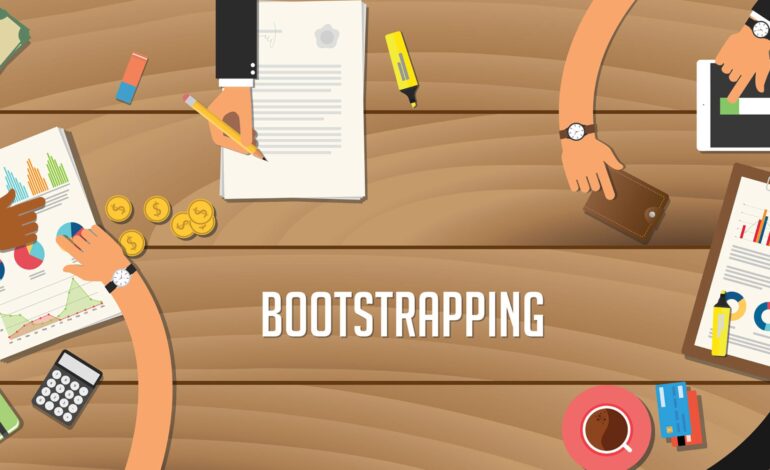
Bootstrapping is a common term in the startup world, and it refers to starting and growing a business with little to no external funding, using personal savings or revenue generated by the business to cover expenses. When you bootstrap your business, you’re doing everything on your own—including finding customers and marketing yourself. You don’t have to worry about investors or banks; instead, you’re responsible for generating revenue in order to pay for all of your costs. There are several pros and cons to bootstrapping your business, which are outlined below.
Pros:
Greater control
Bootstrapping allows you to retain full control over your business since you don’t have to answer to investors or lenders. You can make all the decisions, set your own timeline, and choose your own direction without worrying about meeting anyone else’s expectations. You’re free from having to deal with the restrictions of other people’s money, and you can avoid the hassles that come with managing investors or lenders. You’ll also be able to keep a lot more of what you earn for yourself because you won’t have any outside investors or lenders taking their share out of the profits.
Lower risk
Bootstrapping has lower risk compared to seeking funding from external sources. This means that you have more flexibility to make mistakes and pivot if necessary. Since you are not borrowing money or giving up equity, bootstrapping carries lower risk compared to seeking funding from external sources. This means that you have more flexibility to make mistakes and pivot if necessary.
Increased creativity
Creativity is an important part of business, but it often gets pushed aside in the face of more pressing concerns. When you’re a small company, you have to be creative to get things done. When you have limited resources, you can’t afford to wait around for someone else to come up with the answer for you—you have to come up with the answers yourself. This means finding unique solutions to problems that larger companies might not need to consider.
For example, if your company has only a few people who are capable of designing new products, then it’s critical that those people spend their time on product development instead of doing other tasks like customer service or accounting. If they’re spending time on other tasks, then they’re not working on products! And if they’re not working on products, then your company will eventually lose its edge and go out of business (or at least stop growing).
Stronger foundation

Bootstrapping forces you to focus on generating revenue from day one, which can lead to a more stable foundation for your business. If you have high hopes for your business and want it to grow as fast as possible, then bootstrapping is not for you. You will need to raise money in order to scale up your operations and hire more employees, but this is not necessary if you plan on running the business yourself or with only a few employees.
The main advantage of bootstrapping is that it allows you to keep more control over your company. You will have no debt, which means that if something goes wrong with your business, there are no creditors coming after you for money owed. This gives you more freedom when making decisions about how to run the company and what products/services should be offered.
Cons:
Limited resources
Bootstrapping can limit your ability to invest in growth opportunities or to hire additional staff. This can slow down your business’s growth potential. There are many ways to grow a business without having to take on outside investment, such as using word of mouth marketing, building a network of clients and suppliers, and creating a brand that people want to buy into. However, if you’re looking for a long-term solution that will help you scale your business without having to take on any debt or sell equity, then you may need outside funding.
Lack of credibility
Bootstrapping is a great way to get your business up and running. But the downside is: it can make you lack credibility for your business. Without outside funding, some potential customers, partners, and investors may perceive your business as less credible.
There are ways around this, though! For example, you could use bootstrapping techniques in conjunction with other funding options. By using both types of funding in tandem, you might be able to mitigate any negative impact on your credibility. Or maybe you’ll want to go with another way of raising capital altogether—like getting a loan from a bank or an angel investor. You see? There are many different ways to go about starting a business without needing to take out loans or seek other sources of outside financing!
Slow growth
Bootstrapping can lead to slower growth than other methods, and this is not always a bad thing. If you want to build a long-term business, bootstrapping can be very advantageous. When you are bootstrapping, you do not have access to financial resources that would normally be available from investors or banks. As such, you may not have the ability to invest in marketing or expansion. However, this does not mean that your business cannot grow at all! If you have a great product or service and good customer service, it will be much easier for you to grow your business without outside funding.
You should also consider what type of business model you want before deciding whether or not bootstrapping is right for you. If you want to grow quickly or have an idea for an app that needs capital investment in order for it to become a reality, then bootstrapping may not be right for your company.
Potential burnout

Bootstrapping often requires the entrepreneur to wear multiple hats and work long hours, which can lead to burnout and impact the quality of work. Burnout is a serious issue that affects everyone from entrepreneurs to employees in large companies. It occurs when you are doing too much or not getting enough rest, which causes physical and mental exhaustion. It can be hard to recognize and even harder to cure, but it’s important to take your mental health seriously.
In conclusion, bootstrapping can be a viable option for entrepreneurs who want to maintain control, minimize risk, and be creative with limited resources. However, it can also limit growth potential and lead to burnout if not managed properly.
RUCHI RATHOR Founder & CEO
Payomatix Technologies Pvt. Ltd.
FOUNDER AND INVESTOR | PAYMENTS PROCESSING EXPERT | MERCHANT ACCOUNT SOLUTIONS | WHITE LABELLED PAYMENT GATEWAY | Dreamer, Creator, Achiever, Constantly Evolving
Website Ruchi Rathor: https://ruchirathor.com
Website Healing Heart https://thehealingheart.me/
Instagram https://www.instagram.com/_ruchirathor_/
LinkedIn https://www.linkedin.com/in/ruchirathor12/
Facebook https://www.facebook.com/ruchi.rathor.magnificient
Tumblr https://www.tumblr.com/blog/ruchirathor-thehealingheart
Medium https://medium.com/@ruchirathor_23436









